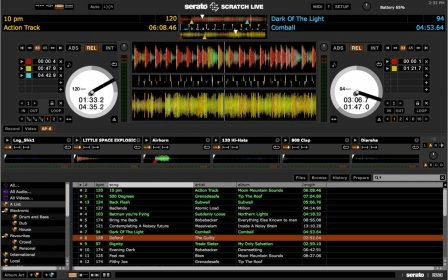Location | Mojave Desert Map |
Mojave National Preserve | Weather | Plants and Animals
Where is the Mojave Desert?
A majority of the Mojave Desert is located in southeastern California and southern Nevada, with smaller portions in Utah and Arizona. The Mojave Desert occupies approximately 43,750 square miles and is considered the smallest and driest desert in the United States.
The Mojave Desert is situated in a transitional zone between the Great Basin Desert to the north and the Sonoran Desert to the south (mainly between 34 and 38°N latitudes).
The Mojave Desert, a rain-shadow desert, is defined by a combination of latitude, elevation, geology, and indicator plants.
MacOS Mojave 10.14 for Rane DJ Products Rane DJ TWELVE and TWELVE MKII - Calibrating the Pitch Fader Important Firmware Update Information For Use With Serato DJ. This list will be kept updated as necessary to reflect all current support for macOS Mojave 10.14 and iOS12. Please be aware, Serato has officially claimed support for macOS Mojave starting with Serato DJ Pro 2.0.5 and Serato DJ Lite 1.0.5. Dec 20, 2011 Scratch Live version 2.3.3 is out. Go get it at serato.com. Fmr National Security Adviser Susan Rice Threatens Snoop Dogg's Life On Twitter - Duration: 14:27. African Diaspora News Channel. SL 3 CoreAudio Driver for Mac OS X 10.11.4 and higher. TTM 57SL Mixer Manual for Scratch Live 2.5.0. TTM57mkII Mixer. TTM57mkII Data Sheet.
Badwater Death Valley 282 feet Below Sea Level
What is the Mojave Desert famous for?
The Mojave Desert is famous for having the hottest air temperature and surface temperature recorded on earth and the lowest elevation in North America.
Furnace Creek, located in Death Valley, recorded 134 F (56.7 C) on July 10th, 2013. On July 15th, 1972, the surface temperature in Furnace Creek was recorded at 201 F (93.9 C).
Badwater Basin, located in Death Valley, is the lowest elevation in the United States. At its lowest point, Badwater Basin measures 279 feet (85 m) below sea level.
Dust Devil in the Mojave Desert
Geography of the Mojave Desert

The Mojave Desert has a typical mountain-and-basin topography with sparse vegetation. Sand and gravel basins drain into central salt flats from which borax, potash and salt are extracted. Silver, tungsten, gold and iron deposits are also present in the Mojave Desert.

Elevations are generally between three and six thousand feet, although Death Valley National Park includes both 11,049-foot Telescope Peak and the lowest point in the United States, 282 feet below sea level, at Badwater Basin.
Weather in the Mojave Desert

Temperatures are a function of both latitude and altitude. Although the Mojave Desert has the lowest absolute elevation and the highest maximum temperature (134°F in Death Valley), it is north of the Sonoran Desert and its average elevations are higher. As a result, its average temperatures are lower than those of the Sonoran Desert.
Plants in the Mojave Desert
Occasional catclaws grow along arroyos. But, unlike the Sonoran Desert, trees are few, both in numbers and diversity in the Mojave Desert. The exception is the Joshua tree. While this unusual tree-like yucca is usually considered the prime indicator of Mojave Desert vegetation, it occurs only at higher elevations in this desert and only in this desert.
The Mojave Desert hosts about 200 endemic plant species found in neither of the adjacent deserts. Cactus are usually restricted to the coarse soils of bajadas. Mojave yucca and, at higher elevations desert Spanish bayonet, a narrow-leafed yucca, are prominent. Creosote bush, shadscale, big sagebrush, bladder-sage, bursages and blackbush are common shrubs of the Mojave Desert.
Animals in the Mojave Desert
A few examples of desert animals that live in the Mojave Desert include: bats, bighorn sheep, coyotes, black-tailed jack rabbits, foxes, rattlesnakes, and chukwallas.
Scratch Live On Mojave Desert
Parks Located in the Mojave Desert
Death Valley National Park
Joshua Tree National Park
Mojave National Preserve (The Mojave Road)
Lake Mead National Recreation Area (NRA)
National Park Service Map
Points of Interest in the Mojave Desert
Scratch Live On Mojave Download
Mojave Road
The Mojave Road crosses the Mojave Preserve and was a main wagon trail for only a relatively short time, two decades after the civil war. When the railroads came, the railways created an easier route to the south complete with oases on the bitter-dry deserts. While it was used, the Mojave Road was a route plagued by hostile Indians, a lack of water, long stretches of sand and rough hill climbs. For caravans of travelers and a handful of soldiers, it was a proving ground that brought out the best and the worst of them. Read more about the Mojave Road.
You might also be interested in:
Motor Home Exploration in the Mojave
Share this page on Facebook:
DesertUSA Newsletter -- We send articles on hiking, camping and places to explore, as well as animals, wildflower reports, plant information and much more. Sign up below or read more about the DesertUSA newsletter here. (It's Free.)
The Desert Environment
The North American Deserts
Desert Geological Terms